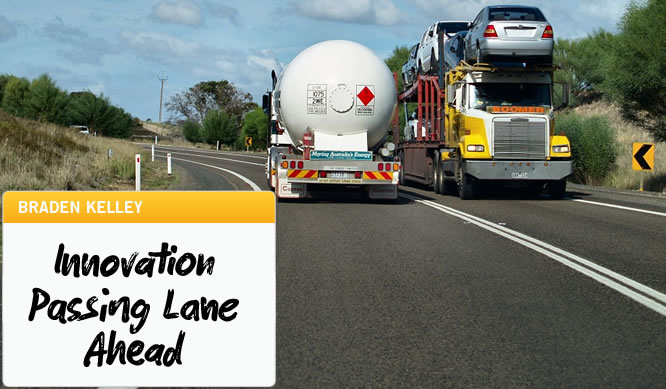
I noticed an interesting phenomenon the other day on a 200 mile drive back from the Oregon coast to Seattle that I would like to share with you and then discuss the potential implications for innovation success.
Now let me first say that I am not a trained human psychologist, but I am a student of human behavior, and I believe that if we watch and listen in other contexts, we can learn amazing things about human behavior that have profound implications for the innovation context. So without further delay, here’s the situation I encountered:
I was driving back along the Columbia River on the Oregon side on a road that was predominantly a two lane road (one lane of traffic in each direction) with passing lanes at various points, typically for the direction of traffic going uphill to give cars a chance to pass slower moving vehicles. Nothing too interesting in that description. Here is where things get interesting…
I noticed that every time I was following a car or truck and approached a passing lane, without exception, the car or truck I was following instantly sped up a minimum of 10mph AND when we reach the end of the passing lane area, they pretty quickly slowed down 10mph.
Now, why would every driver I encountered in front of me (without exception) speed up when the passing lane approached and slow down when it ended, even though the speed limit was unchanged? What’s the psychology behind this behavior?
Here are my observations:
- On a two lane road there are leaders and there are followers. When you are a leader the whole road is before you and you set the speed, when you are a follower you are at the mercy of the person in front of you to set the speed and all you see is the back of the vehicle in front of you. People enjoy having the open road in front of them and even if they are not fast drivers, they are willing to drive a little bit faster to try and retain this privilege (about 10mph faster).
- Passing lanes represent a limited window of opportunity for people seeking to pass, and a limited duration of resistance for those looking not to be passed. Because the duration is limited, the leader perceives a threat and a scarcity that they would not perceive on a road that was always two lanes in their direction. As a result, their behavior is different.
- If you want to pass someone as a passing lane approaches, you must be prepared to drive 20mph faster to execute the pass before the end of the passing lane, knowing that the person in front of you is not going to stay constant, but will actually speed up.
What are the implications for innovation?
- There are always going to be people coming up behind you, seeking to pass you. Innovation is one way to stay ahead of the competition. Incremental innovation can be your 10mph acceleration that reduces the chance of being passed when the passing lanes appear.
- You must be aware when the passing lanes will appear. This is often when new technology makes things possible that weren’t possible before or when customer priorities and value assignment changes. Market leaders must recognize the conditions that create passing lanes and form a plan for how to protect themselves, while new entrants must recognize when their opportunity is greatest and move quickly and decisively before the passing lane comes to an end.
- You must provide the conditions necessary to make people want to rush into the widening road and seek to accelerate innovation and overtake the other drivers, instead of embracing the safety of the shoulder of the road as others rush by.
- People won’t push harder forever. This is the psychology around creating a burning platform. People will fight the fire on a burning platform, but if they feel that the whole house is on fire, then they will look for a new house. As a result a burning-platform approach to innovation is not sustainable, you must instead be much more systemic in your approach to innovation if you are going to use it to help protect your market leadership position.
- When a passing lane appears, market leaders must take a careful measurement of the situation and identify how best to react to the factors that have created it. At the same time, market leaders must also identify how long they must push to kill off potential new entrants.
- If you’re trying to innovate your way into first place, you must expect the leader to react, and anticipate the way in which they will react and account for that. You must know that the market leaders will look for how to starve you of your oxygen, and will look to accelerate away from you. This is why the most successful passers are those organizations that recognize the passing lane first, are mobilized to accelerate when it appears, and choose to react to the passing lane in a way that will be difficult for the market leaders to react to given their position and psychology.
Competition in a free market economy is not fair, and the playing field is not level, and the road ahead is not an open highway but a two lane road with occasional passing lanes. The organizations that do the best job at identifying when the passing lanes are going to appear and the factors that are going to allow them to accelerate are the ones that will either leapfrog the existing leaders, or maintain their ongoing market leadership.
What kind of organization are you going to be?
![]() Sign up here to get Human-Centered Change & Innovation Weekly delivered to your inbox every week.
Sign up here to get Human-Centered Change & Innovation Weekly delivered to your inbox every week.
